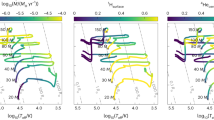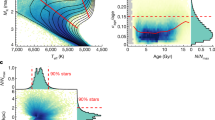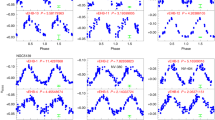Abstract
Horizontal branch stars belong to an advanced stage in the evolution of the oldest stellar galactic population, occurring either as field halo stars or grouped in globular clusters. The discovery of multiple populations in clusters1,2 that were previously believed to have single populations gave rise to the currently accepted theory that the hottest horizontal branch members (the ‘blue hook’ stars, which had late helium-core flash ignition3, followed by deep mixing4,5) are the progeny of a helium-rich ‘second generation’ of stars6,7. It is not known why such a supposedly rare event8,9 (a late flash followed by mixing) is so common that the blue hook of ω Centauri contains approximately 30 per cent of the horizontal branch stars in the cluster10, or why the blue hook luminosity range in this massive cluster cannot be reproduced by models. Here we report that the presence of helium core masses up to about 0.04 solar masses larger than the core mass resulting from evolution is required to solve the luminosity range problem. We model this by taking into account the dispersion in rotation rates achieved by the progenitors, whose pre-main-sequence accretion disk suffered an early disruption in the dense environment of the cluster’s central regions, where second-generation stars form11. Rotation may also account for frequent late-flash–mixing events in massive globular clusters.
This is a preview of subscription content, access via your institution
Access options
Subscribe to this journal
Receive 51 print issues and online access
$199.00 per year
only $3.90 per issue
Buy this article
- Purchase on Springer Link
- Instant access to full article PDF
Prices may be subject to local taxes which are calculated during checkout



Similar content being viewed by others
References
Gratton, R. G., Carretta, E. & Bragaglia, A. Multiple populations in globular clusters. Lessons learned from the Milky Way globular clusters. Astron. Astrophys. Rev. 20, 50 (2012)
Piotto, G. et al. Hubble Space Telescope reveals multiple sub-giant branch in eight globular clusters. Astrophys. J. 760, 39 (2012)
D’Cruz, N. L., Dorman, B., Rood, R. T. & O’Connell, R. W. The origin of extreme horizontal branch stars. Astrophys. J. 466, 359 (1996)
Moehler, S., Sweigart, A. V., Landsman, W. B. & Heber, U. Hot HB stars in globular clusters—physical parameters and consequences for theory. V. Radiative levitation versus helium mixing. Astron. Astrophys. 360, 120–132 (2000)
Brown, T. M., Sweigart, A. V., Lanz, T., Landsman, W. B. & Hubeny, I. Flash mixing on the white dwarf cooling curve: understanding hot horizontal branch anomalies in NGC 2808. Astrophys. J. 562, 368–393 (2001)
D’Antona, F., Caloi, V., Montalbán, J., Ventura, P. & Gratton, R. Helium variation due to self-pollution among Globular Cluster stars. Consequences on the horizontal branch morphology. Astron. Astrophys. 395, 69–75 (2002)
Brown, T. M. et al. Flash mixing on the white dwarf cooling curve: spectroscopic confirmation in NGC 2808. Astrophys. J. 748, 85 (2012)
Miller Bertolami, M. M., Althaus, L. G., Unglaub, K. & Weiss, A. Modeling He-rich subdwarfs through the hot-flasher scenario. Astron. Astrophys. 491, 253–265 (2008)
Brown, T. M. et al. The blue hook populations of massive globular clusters. Astrophys. J. 718, 1332–1344 (2010)
Anderson, J. & van der Marel, R. P. New limits on an intermediate-mass black hole in Omega Centauri. I. Hubble Space Telescope photometry and proper motions. Astrophys. J. 710, 1032–1062 (2010)
D’Ercole, A., Vesperini, E., D’Antona, F., McMillan, S. L. W. & Recchi, S. Formation and dynamical evolution of multiple stellar generations in globular clusters. Mon. Not. R. Astron. Soc. 391, 825–843 (2008)
Sweigart, A. V. Helium mixing in globular cluster stars. In Third Conf. on Faint Blue Stars (eds Philip, A. G. D., Liebert, J., Saffer, R. & Hayes, D. S. ) 3–27 (L. Davis Press, 1997)
Cassisi, S., Schlattl, H., Salaris, M. & Weiss, A. First full evolutionary computation of the helium flash-induced mixing in population II stars. Astrophys. J. 582, L43–L46 (2003)
Whitney, J. H. et al. Far-ultraviolet photometry of the globular cluster omega CEN. Astron. J. 108, 1350–1363 (1994)
Bellini, A. et al. A double white-dwarf cooling sequence in ω Centauri. Astrophys. J. 769, L32 (2013)
Moehler, S. et al. The hottest horizontal-branch stars in ω Centauri. Late hot flasher vs. helium enrichment. Astron. Astrophys. 475, L5–L8 (2007)
Latour, M. et al. A helium-carbon correlation on the extreme horizontal branch in ω Centauri. Astrophys. J. 795, 106 (2014)
Mengel, J. G. & Gross, P. G. Possible effects of internal rotation in low-mass stars. Astrophys. Space Sci. 41, 407–415 (1976)
Bekki, K. Rotation and multiple stellar population in globular clusters. Astrophys. J. 724, L99–L103 (2010)
Bellini, A. et al. Radial distribution of the multiple stellar populations in ω Centauri. Astron. Astrophys. 507, 1393–1408 (2009)
Armitage, P. J. & Clarke, C. J. Magnetic braking of T Tauri stars. Mon. Not. R. Astron. Soc. 280, 458–468 (1996)
Bouvier, J., Forestini, M. & Allain, S. The angular momentum evolution of low-mass stars. Astron. Astrophys. 326, 1023–1043 (1997)
Weiss, A., Denissenkov, P. A. & Charbonnel, C. Evolution and surface abundances of red giants experiencing deep mixing. Astron. Astrophys. 356, 181–190 (2000)
D’Antona, F. & Ventura, P. A model for globular cluster extreme anomalies. Mon. Not. R. Astron. Soc. 379, 1431–1441 (2007)
Piotto, G. et al. The Hubble Space Telescope UV Legacy Survey of Galactic Globular Clusters. I. Overview of the project and detection of multiple stellar populations. Astron. J. 149, 9 (2015)
Di Criscienzo, M. et al. An HST/WFC3 view of stellar populations on the horizontal branch of NGC 2419. Mon. Not. R. Astron. Soc. 446, 1469–1477 (2015)
Caloi, V. & D’Antona, F. NGC 6441: another indication of very high helium content in globular cluster stars. Astron. Astrophys. 463, 949–955 (2007)
Bellini, A. et al. The intriguing stellar populations in the globular clusters NGC 6388 and NGC 6441. Astrophys. J. 765, 32 (2013)
Salaris, M., Cassisi, S. & Pietrinferni, A. The horizontal branch of NGC 1851: constraints on the cluster subpopulations. Astrophys. J. 678, L25–L28 (2008)
D’Antona, F. et al. The puzzle of metallicity and multiple stellar populations in the globular clusters in Fornax. Mon. Not. R. Astron. Soc. 434, 1138–1150 (2013)
Cardelli, J. A., Clayton, G. C. & Mathis, J. S. The relationship between infrared, optical, and ultraviolet extinction. Astrophys. J. 345, 245–256 (1989)
O’Donnell, J. E. Rnu-dependent optical and near-ultraviolet extinction. Astrophys. J. 422, 158–163 (1994)
Moehler, S. et al. The hot horizontal-branch stars in ω Centauri. Astron. Astrophys. 526, A136 (2011)
Ventura, P., D’Antona, F. & Mazzitelli, I. The ATON 3.1 stellar evolutionary code. A version for asteroseismology. Astrophys. Space Sci. 316, 93–98 (2008)
Castellani, M. & Castellani, V. Mass loss in globular cluster red giants—an evolutionary investigation. Astrophys. J. 407, 649–656 (1993)
Michaud, G., Richer, J. & Richard, O. Horizontal branch evolution and atomic diffusion. Astrophys. J. 670, 1178–1187 (2007)
Michaud, G., Richer, J. & Richard, O. Abundance anomalies in horizontal branch stars and atomic diffusion. Astrophys. J. 675, 1223–1232 (2008)
Gallet, F. & Bouvier, J. Improved angular momentum evolution model for solar-like stars. Astron. Astrophys. 556, A36 (2013)
Palacios, A., Talon, S., Charbonnel, C. & Forestini, M. Rotational mixing in low-mass stars. I. Effect of the μ-gradients in main sequence and subgiant Pop I stars. Astron. Astrophys. 399, 603–616 (2003)
Spada, F., Lanzafame, A. C., Lanza, A. F., Messina, S. & Collier Cameron, A. Modelling the rotational evolution of solar-like stars: the rotational coupling time-scale. Mon. Not. R. Astron. Soc. 416, 447–456 (2011)
Charbonnel, C. & Talon, S. Influence of gravity waves on the internal rotation and Li abundance of solar-type stars. Science 309, 2189–2191 (2005)
Castelli, F. & Kurucz, R. L. New grids of ATLAS9 model atmospheres. Preprint at http://arxiv.org/abs/astro-ph/0405087 (2004)
D’Antona, F. & Caloi, V. The fraction of second generation stars in globular clusters from the analysis of the horizontal branch. Mon. Not. R. Astron. Soc. 390, 693–705 (2008)
Ventura, P. & D’Antona, F. Hot bottom burning in the envelope of super asymptotic giant branch stars. Mon. Not. R. Astron. Soc. 410, 2760–2766 (2011)
Cassisi, S. et al. Hot horizontal branch stars in ω Centauri: clues about their origin from the cluster color magnitude diagram. Astrophys. J. 702, 1530–1535 (2009)
Binney, J. & Tremaine, S. Galactic Dynamics 2nd edn (Princeton Univ. Press, 2008)
Acknowledgements
A.P.M. acknowledges support by the Australian Research Council through Discovery Early Career Researcher Award DE150101816. E.V. acknowledges support from grant NASANNX13AF45G. P.V. and F.D’A. acknowledge support from PRIN INAF 2011 “Multiple populations in globular clusters: their role in the Galaxy assembly” (principal investigator E. Carretta), and P.V. acknowledges support from PRIN MIUR 2010-2011, project “The Chemical and Dynamical Evolution of the Milky Way and Local Group Galaxies” (principal investigator F. Matteucci). T.D. acknowledges support from the UE Program (FP7/2007–2013) under grant agreement number 267251 of Astronomy Fellowships in Italy (ASTROFit). M.D.C. acknowledges support from INAF-OAR. A.B. acknowledges support from STScI grant AR-12656.
Author information
Authors and Affiliations
Contributions
M.T., F.D’A., E.V. and M.D.C. jointly designed and coordinated this study. F.D’A. proposed and designed the rotational evolution model. E.V. designed and computed the dynamical simulation. M.T. and P.V. computed the new evolutionary models. A.D. computed synthetic colours with an internally consistent treatment of extinction across all bandpasses. M.T. and M.D.C. performed the simulations and the analysis. A.B. performed the data reduction and calibration for the WFC3/UVIS exposures. A.M. dealt with the optical data and the comparison with spectroscopic data. T.D. dealt with the problems connected to the modelling of stellar rotation. V.C. contributed to the discussion and to the writing of the text. A.D’E. and R.C.-D. provided insight on the dynamical aspects. All authors read, commented on and approved submission of this article.
Corresponding author
Ethics declarations
Competing interests
The authors declare no competing financial interests.
Extended data figures and tables
Extended Data Figure 1 Comparison simulation versus optical data.
The observed data10 are shown as grey dots. The diagonal line suggests the division between blue hook and cooler extreme horizontal branch stars. a, Tracks shown are for M = 0.466M⊙, Y = 0.37 and evolutionary Mc = 0.463M⊙ (black solid line), plus the corresponding track in which Mc is increased by 0.04M⊙ (magenta solid line). The zero-age horizontal branch for Y = 0.37 (dashed black) and the 0.471M⊙ track (dotted black) are also shown. b, Result of the coupled dynamical–evolutionary simulation (detailed explanation in Fig. 1).
Extended Data Figure 2 Models with helium versus hydrogen diffusion.
a and b show a comparison of blue hook tracks from Xenv-in = 0.007 to Xenv-in = 0.41, from left to right, for Mturb = 10−6M⊙ (full lines) and 10−7M⊙ (dashed lines). The bolometric luminosity (b) and the F225W magnitude (a) are shown as function of Teff. The hot side of the zero-age horizontal branch for Y = 0.37 is shown (solid black line with dots). c, Evolution with time of the surface N(He)/N(H) due to diffusion. The solar ratio is shown as a horizontal grey dotted line. The observations of blue hook stars show that the slower diffusion is a better description (Fig. 2).
Extended Data Figure 3 Simulation versus data, including first- and second-generation stars.
As in Fig. 1 and Extended Data Fig. 1, but the ultraviolet data are compared with a simulation assuming that 50% of blue hook stars are the progeny of the Y = 0.37 population (squares), and 50% are progeny of the Y = 0.25 population (triangles). The error bars are the result of individual 1σ Poisson error on the stellar counts.
Extended Data Figure 4 Tracks and simulation versus data including models having Xenv-in > 0.06.
As in Fig. 1. a, Tracks with different Xenv-in values and the end of the zero-age horizontal branch (black line with dots) with the location of the minimum non-mixed track (dotted black line) for Y = 0.37. b, Simulation including Xenv-in up to 0.21, for the listed percentages of stars. c, Simulation also including stars with Xenv-in = 0.41. In the latter simulation, the main aim is to show that the most hydrogen-rich stars are located on the extreme horizontal branch, and not on the blue hook.
Extended Data Figure 5 The dynamical model.
Two different cases of dynamical interactions are compared: either we make the hypothesis that the magnetic coupling of the disk is destroyed by one encounter with another star, at a distance entering the accretion disk (<100 au), or that three such encounters are necessary. a, A histogram of encounters versus time of detachment. b, Initial rotation period distribution employed in the two cases. c, Resulting distribution of the core mass increase, which is an initial parameter in the photometric simulation.
Rights and permissions
About this article
Cite this article
Tailo, M., D’Antona, F., Vesperini, E. et al. Rapidly rotating second-generation progenitors for the ‘blue hook’ stars of ω Centauri. Nature 523, 318–321 (2015). https://doi.org/10.1038/nature14516
Received:
Accepted:
Published:
Issue Date:
DOI: https://doi.org/10.1038/nature14516
This article is cited by
-
Asteroseismic signatures of the helium core flash
Nature Astronomy (2019)
Comments
By submitting a comment you agree to abide by our Terms and Community Guidelines. If you find something abusive or that does not comply with our terms or guidelines please flag it as inappropriate.



